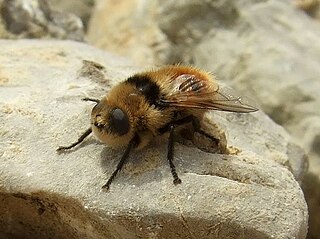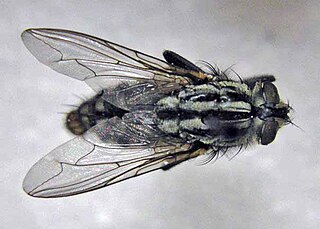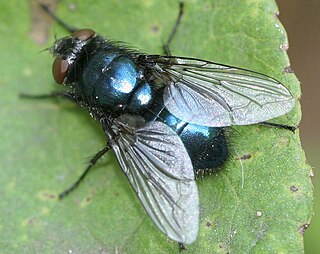
A maggot is the larva of a fly ; it is applied in particular to the larvae of Brachycera flies, such as houseflies, cheese flies, and blowflies, rather than larvae of the Nematocera, such as mosquitoes and crane flies.

The Calliphoridae are a family of insects in the order Diptera, with almost 1,900 known species. The maggot larvae, often used as fishing bait, are known as gentles. The family is known to be polyphyletic, but much remains disputed regarding proper treatment of the constituent taxa, some of which are occasionally accorded family status.

Botflies, also known as warble flies, heel flies, and gadflies, are a family of flies known as the Oestridae. Their larvae are internal parasites of mammals, some species growing in the host's flesh and others within the gut. Dermatobia hominis is the only species of botfly known to parasitize humans routinely, though other species of flies cause myiasis in humans.

The sterile insect technique (SIT) is a method of biological insect control, whereby overwhelming numbers of sterile insects are released into the wild. The released insects are preferably male, as this is more cost-effective and the females may in some situations cause damage by laying eggs in the crop, or, in the case of mosquitoes, taking blood from humans. The sterile males compete with fertile males to mate with the females. Females that mate with a sterile male produce no offspring, thus reducing the next generation's population. Sterile insects are not self-replicating and, therefore, cannot become established in the environment. Repeated release of sterile males over low population densities can further reduce and in cases of isolation eliminate pest populations, although cost-effective control with dense target populations is subjected to population suppression prior to the release of the sterile males.

Myiasis, also known as flystrike or fly strike, is the parasitic infestation of the body of a live animal by fly larvae (maggots) that grow inside the host while feeding on its tissue. Although flies are most commonly attracted to open wounds and urine- or feces-soaked fur, some species can create an infestation even on unbroken skin and have been known to use moist soil and non-myiatic flies as vector agents for their parasitic larvae.

Cochliomyia hominivorax, the New World screwworm fly, or simply screwworm or screw-worm, is a species of parasitic fly that is well known for the way in which its larvae (maggots) eat the living tissue of warm-blooded animals. It is present in the New World tropics. There are five species of Cochliomyia but only one species of screwworm fly in the genus is parasitic; there is also a single Old World species in a different genus. Infestation of a live vertebrate animal by a maggot is technically called myiasis. While the maggots of many fly species eat dead flesh, and may occasionally infest an old and putrid wound, screwworm maggots are unusual because they attack healthy tissue.

Chrysomya putoria, also known as the tropical African latrine blowfly, is a fly species belonging to the blowfly family, Calliphoridae.C. putoria is native to Africa and has recently spread to the Americas. These flies pose significant health risks, especially due to their close association with human settlements. Adult flies can carry pathogens, while larvae may cause myiasis by growing and feeding on the flesh of domestic animals and humans. Other myiasis-causing flies in the same genus are C. bezziana and C. megacephala. C. putoria and other flies that feed on decomposing tissue are used as important tools in forensic entomology to establish the post-mortem interval, or the time elapsed since death.

Chrysomya is an Old World blow fly genus of the family Calliphoridae. The genus Chrysomya contains a number of species including Chrysomya rufifacies and Chrysomya megacephala. The term “Old World blow fly” is a derivative of both the associated family, Calliphoridae, and the belief that the genus Chrysomya originated in Asia and migrated to North America only relatively recently. Chrysomya’s primary importance to the field of medico-criminal forensic entomology is due to the genus’ reliable life cycle, allowing investigators to accurately develop a postmortem interval. Chrysomya adults are typically metallic colored with thick setae on the meron and plumose arista. The name comes from the word chrysos, meaning “golden” in reference to the metallic sheen of the genus’ species, and -mya, a derivation from the word myia, meaning “fly”.

Chrysomya rufifacies is a species belonging to the blow fly family, Calliphoridae, and is most significant in the field of forensic entomology due to its use in establishing or altering post mortem intervals. The common name for the species is the hairy maggot blow fly, and it belongs to the genus Chrysomya, which is commonly referred to as the Old World screwworms. This genus includes other species such as Chrysomya putoria and Chrysomya bezziana, which are agents of myiasis. C. rufifacies prefers very warm weather and has a relatively short lifecycle. It is widely distributed geographically and prefers to colonize large carcasses over small ones. The species commonly has a greenish metallic appearance and is important medically, economically, and forensically.

Lucilia illustris is a member of the fly family Calliphoridae, commonly known as a blow fly. Along with several other species, L. illustris is commonly referred to as a green bottle fly. Lucilia illustris is typically 6–9 mm in length and has a metallic blue-green thorax. The larvae develop in three instars, each with unique developmental properties. The adult fly typically will feed on flowers, but the females need some sort of carrion protein in order to breed and lay eggs.

Chrysomya albiceps is a species belonging to the blow fly family, Calliphoridae.

Chrysomya bezziana, also known as the Old World screwworm fly or screwworm, is an obligate parasite of mammals. Obligate parasitic flies require a host to complete their development. Named to honor the Italian entomologist Mario Bezzi, this fly is widely distributed in Asia, tropical Africa, India, and Papua New Guinea. The adult can be identified as metallic green or blue with a yellow face and the larvae are smooth, lacking any obvious body processes except on the last segment.

Sarcophaga pernix, also known as the red-tailed flesh fly, is a fly in the Sarcophagidae family. This fly often breeds in carrion and feces, making it a possible vector for disease. The larvae of this species can cause myiasis, as well as accidental myiasis. It is potentially useful in forensic entomology.
Lucilia thatuna belongs to the family Calliphoridae, the species most commonly referred to as the blowflies, and the genus Lucilia. Along with several other species of Lucilia, L. thatuna is commonly referred to as a green bottle fly. L. thatuna is very scarce and not much is known about this particular fly. It has been noted to reside in mountainous regions of the northwestern United States.

Lucilia cuprina, formerly named Phaenicia cuprina, the Australian sheep blowfly is a blow fly in the family Calliphoridae. It causes the condition known as "sheep strike"'. The female fly locates a sheep with ideal conditions, such as an open wound or a build-up of faeces or urine in the wool, in which she lays her eggs. The emerging larvae cause large lesions on the sheep, which may prove to be fatal.

Calliphora livida is a member of the family Calliphoridae, the blow flies. This large family includes the genus Calliphora, the "blue bottle flies". This genus is important in the field of forensic entomology because of its value in post-mortem interval estimation.

Protophormia terraenovae is commonly called northern blowfly, blue-bottle fly or blue-assed fly. It is distinguished by its deep blue coloration and large size and is an important species throughout the Northern Hemisphere. This fly is notable for its economic effect as a myiasis pest of livestock and its antibiotic benefits in maggot therapy. Also of interest is P. terraenovae’s importance in forensic investigations: because of their temperature-dependent development and their prominent presence on corpses, the larvae of this species are useful in minimum post-mortem interval (mPMI) determination.

Many species of flies of the two-winged type, Order Diptera, such as mosquitoes, horse-flies, blow-flies and warble-flies, cause direct parasitic disease to domestic animals, and transmit organisms that cause diseases. These infestations and infections cause distress to companion animals, and in livestock industry the financial costs of these diseases are high. These problems occur wherever domestic animals are reared. This article provides an overview of parasitic flies from a veterinary perspective, with emphasis on the disease-causing relationships between these flies and their host animals. The article is organized following the taxonomic hierarchy of these flies in the phylum Arthropoda, order Insecta. Families and genera of dipteran flies are emphasized rather than many individual species. Disease caused by the feeding activity of the flies is described here under parasitic disease. Disease caused by small pathogenic organisms that pass from the flies to domestic animals is described here under transmitted organisms; prominent examples are provided from the many species.

Cochliomyia macellaria, also known as the secondary screwworm, is a species of blow fly in the family Calliphoridae. These screwworms are referred to as "secondary" because they typically infest wounds after invasion by primary myiasis-causing flies. While blow flies may be found in every terrestrial habitat, C. macellaria is primarily found in the United States, American tropics, and sometimes southern Canada. They are most common in the southeastern United States in states like Florida. C. macellaria have a metallic greenish-blue thorax and a red-orange head and eyes. These adult blowflies range from 5–8 mm in size.

Raymond C. Bushland was an American entomologist. He was awarded the 1992 World Food Prize with his colleague Edward F. Knipling for their combined efforts in the development of the sterile insect technique (SIT).





















